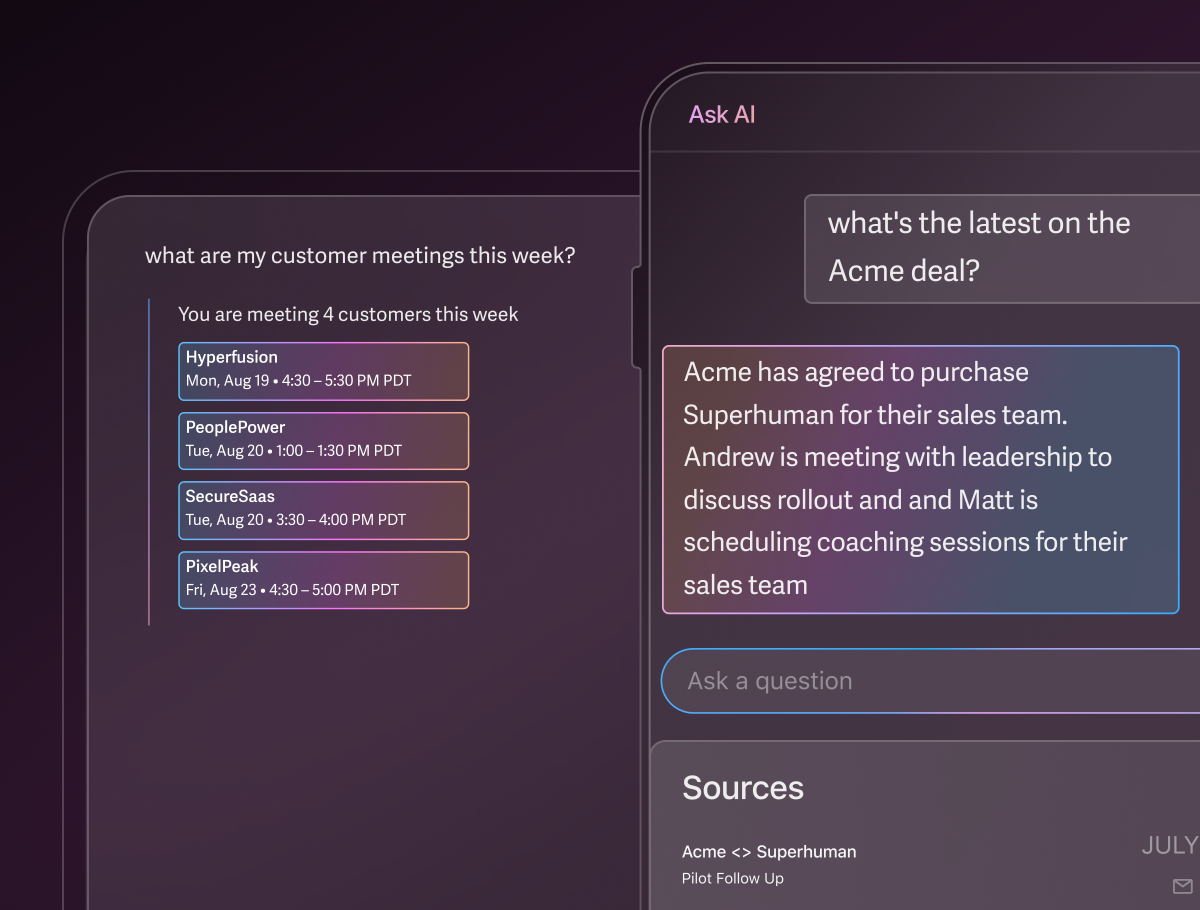
At one of the large U.S.-based strategy consulting firms, the AI stack for managing partners consists of Superhuman, an email productivity software, and ChatGPT, OpenAI's AI chatbot, according to Superhuman CEO Rahul Vohra.
"They have evaluated hundreds of AI products over the last six months, and the only two that they bought were ChatGPT and Superhuman," Vohra told Newsweek. Since the timing of that conversation, of course, the firm may have added more AI tools.
Vohra said the firm's internal analysis determined that users saved 3.3 hours per week using Superhuman and around the same amount of time using ChatGPT. Those results were from a pilot program with around 50 participants before Superhuman was rolled out to their 4,000 senior leaders at a managing director level, which included partners as well.
Data that Superhuman shared with Newsweek also showed that this population was responding to emails 3.6 hours faster on average and sending 60 percent more emails. Perhaps Superhuman is offering an AI-powered path to inbox-zero, which can be a particularly notable goal for people who experience high-volume inbound communication, like consulting partners.
"They receive hundreds of emails, in some cases thousands of emails every single day that they have to deal with, so they don't have a minute to waste and they need to be on top of their emails," Vohra said. "It's the primary way that they communicate with their clients."
In consulting and other professional services firms, it's often said that the people are the product. If people are more productive using AI, that has a direct connection to improvements in the quality and delivery of a firm's services.
"If you are working a book of business, trying to close customers, trying to retain those customers, grow those accounts, sell new projects…response time is super important," Vohra said. "Even zooming out of customer interaction, the speed at which a firm like [this] moves, in general, boils down to how fast people are communicating with each other."
Vohra shared that the most-used Superhuman features among the consulting leaders were reminders, read status, AI-driven summaries and first drafts. The tool is also able to split inboxes by source and query inboxes for information. Of the 4,000 leaders, Superhuman shared that 1,500 are active users of their software.
"What do those [senior leaders] actually do all day?" Vohra said. "They're either servicing existing projects, proactively building their book of business…trying to sell new projects, or they are helping run the company. They have management responsibility and decision-making responsibility" as stewards of the firm.
Another thing Vohra said his consulting client and others have liked about their adoption of Superhuman is that they say they're "never dropping the ball." He also shared a client testimonial saying that beyond saving time, the ease on "stress and mental load" around email and communications was helpful.
"Every interaction is just so important," Vohra added. "You can't have a customer email you and nobody gets back…so this idea that nothing falls through the cracks is super important to them."
Discovering and Rolling Out AI Solutions
Of course, finding interesting software and implementing it across thousands of people so that they actually use it are two distinct tasks.
For the consulting firm, a leader who was tasked with finding AI tools for the most senior groups was using Superhuman in their personal emails and brought it internally for consideration.
Vohra described this user-buyer at the firm as an "AI native," as much as someone not in technology can be, and in many ways a "classic executive sponsor—they're optimistic, know how to move things internally, the archetypical first buyer."
This partner then shared Superhuman with a few peers and launched the pilot before taking the solution to the firm's central workplace-technology team for further evaluation, Vohra said.
That pilot produced the data mentioned in this article and went up to senior-most executives at the firm before it was approved for widespread use in the 4,000-person population of senior leaders this initiative was meant to serve.
Vohra added that the consulting firm's tight rollout process also contributed to the successful uptake in Superhuman, and likely other tools and technology.
The firm made the rare decision to invite Superhuman as a vendor to its annual conference of senior leaders to demonstrate the tech and its capabilities. It deployed a "tiger team" of internal advocates and also had its IT support staff trained on how to coach people to use Superhuman. The company's most senior leadership also advocated for the product after approving the decision to buy it and roll it out, and Superhuman provided "concierge-style" one-on-one onboarding for the firm's new users if they requested it.
While this may have the structure of a typical software adoption story, it also includes the element of artificial intelligence. Vohra, a serial entrepreneur who sold his previous company to LinkedIn in 2012 before launching Superhuman in 2014, said the digital transformation that has been occurring in businesses over the last two decades is similar to the AI and machine-learning transformation now occurring, except that this new cycle will likely go faster, he thinks.
Either way, emerging technology has the potential to save people and companies lots of time and money, and in competitive industries, this can make a difference on productivity, customer satisfaction and the bottom line. There's a reason top consulting firms are looking into this technology and deploying it.

"We sometimes say that email is the biggest problem hiding in plain sight," Vohra said, saying that workers spend around three hours per day on average on emails. Some pre-pandemic studies had this figure at more than five hours per day. A 2023 survey from Microsoft found that 68 percent of workers say they don't have enough uninterrupted focus time in their workdays.
"It's such a blind spot, and it's not anybody's fault. We've been conditioned to think that that's the way it always is," he said. "When most of us entered the workforce, Gmail and Outlook were substantially the same as they are today. That's kind of crazy when you think about it."
While some fears exist around AI and its deployment, it also does not have to be life-changing to adopt it for improvement. Most people don't know how email works as a technology, but they appreciate that they can write a message and send it to colleagues and clients. Today, AI is having a similar impact with or without the knowledge that groundbreaking machine-learning technology is being used.
"Without fail, almost always, the reason why people reach out to us is that every single company is going to go through an AI transformation," Vohra shared. "They want to be amongst the first."
Correction 2/14/2025, 4:50 p.m. ET: This article has been corrected to reflect that the data showing decreased response times to emails, more email productivity and the number of hours saved per week was provided by Superhuman.
About the writer
Aman Kidwai is a Newsweek editor based in New Haven, Connecticut. His focus is reporting on the labor market, careers, ... Read more



